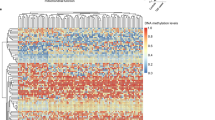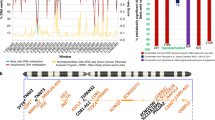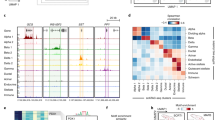Abstract
The regulation of islet cell biology is critical for glucose homeostasis1. N6-methyladenosine (m6A) is the most abundant internal messenger RNA (mRNA) modification in mammals2. Here, we report that the m6A landscape segregates human type 2 diabetes (T2D) islets from controls significantly better than the transcriptome and that m6A is vital for β-cell biology. m6A sequencing in human T2D islets reveals several hypomethylated transcripts that are involved in cell-cycle progression, insulin secretion, and the insulin/IGF1–AKT–PDX1 pathway. Depletion of m6A levels in EndoC-βH1 cells induces cell-cycle arrest and impairs insulin secretion by decreasing AKT phosphorylation and PDX1 protein levels. β-cell-specific Mettl14 knockout mice, which display reduced m6A levels, mimic the islet phenotype in human T2D with early diabetes onset and mortality owing to decreased β-cell proliferation and insulin degranulation. Our data underscore the significance of RNA methylation in regulating human β-cell biology, and provide a rationale for potential therapeutic targeting of m6A modulators to preserve β-cell survival and function in diabetes.
This is a preview of subscription content, access via your institution
Access options
Access Nature and 54 other Nature Portfolio journals
Get Nature+, our best-value online-access subscription
$29.99 / 30 days
cancel any time
Subscribe to this journal
Receive 12 digital issues and online access to articles
$119.00 per year
only $9.92 per issue
Buy this article
- Purchase on Springer Link
- Instant access to full article PDF
Prices may be subject to local taxes which are calculated during checkout




Similar content being viewed by others
Data availability
m6A sequencing and RNA sequencing data in human islets have been deposited with the National Center for Biotechnology Information Gene Expression Omnibus under accession code GSE120024. m6A sequencing and RNA sequencing data in EndoC-βH1 cells have been deposited under accession code GSE132306. RNA sequencing in mouse FACS-sorted β-cells have been deposited under the accession code GSE132306. Phospho-antibody microarray data performed in mouse whole islets have been deposited under the accession code GSE132111.The data that support the findings of this study are available from the corresponding author upon reasonable request. R package RADAR code is available upon request.
References
De Jesus, D. F. & Kulkarni, R. N. Epigenetic modifiers of islet function and mass. Trends Endocrinol. Metab. 25, 628–636 (2014).
Frye, M., Harada, B. T., Behm, M. & He, C. RNA modifications modulate gene expression during development. Science 361, 1346–1349 (2018).
Taneera, J. et al. Silencing of the FTO gene inhibits insulin secretion: an in vitro study using GRINCH cells. Mol. Cell. Endocrinol. 472, 10–17 (2018).
Xin, Y. et al. RNA sequencing of single human islet cells reveals type 2 diabetes genes. Cell Metab. 24, 608–615 (2016).
Wang, X. et al. N 6-methyladenosine-dependent regulation of messenger RNA stability. Nature 505, 117 (2013).
Fadista, J. et al. Global genomic and transcriptomic analysis of human pancreatic islets reveals novel genes influencing glucose metabolism. Proc. Natl Acad. Sci. 111, 13924–13929 (2014).
Gromada, J., Chabosseau, P. & Rutter, G. A. The α-cell in diabetes mellitus. Nat. Rev. Endocrinol. 14, 694–704 (2018).
Diedisheim, M. et al. Modeling human pancreatic beta cell dedifferentiation. Mol. Metab. 10, 74–86 (2018).
Laukkanen, O. et al. Polymorphisms in the SLC2A2 (GLUT2) gene are associated with the conversion from impaired glucose tolerance to type 2 diabetes: the finnish diabetes prevention study. The Finnish Diabetes Prevention Study 54, 2256–2260 (2005).
Wang, Y. et al. N 6-methyladenosine RNA modification regulates embryonic neural stem cell self-renewal through histone modifications. Nat. Neurosci. 21, 195–206 (2018).
Kulkarni, R. N. et al. PDX-1 haploinsufficiency limits the compensatory islet hyperplasia that occurs in response to insulin resistance. J. Clin. Invest. 114, 828–836 (2004).
Stoffers, D. A., Zinkin, N. T., Stanojevic, V., Clarke, W. L. & Habener, J. F. Pancreatic agenesis attributable to a single nucleotide deletion in the human IPF1 gene coding sequence. Nat. Genet. 15, 106 (1997).
Guo, S. et al. Inactivation of specific β cell transcription factors in type 2 diabetes. J. Clin. Invest. 123, 3305–3316 (2013).
Humphrey, R. K., Yu, S.-M., Flores, L. E. & Jhala, U. S. Glucose regulates steady-state levels of PDX1 via the reciprocal actions of GSK3 and AKT kinases. J. Biol. Chem. 285, 3406–3416 (2010).
Elghazi, L. & Bernal-Mizrachi, E. Akt and PTEN: beta-cell mass and pancreas plasticity. Trends Endocrinol. Metab. 20, 243–251 (2009).
Ravassard, P. et al. A genetically engineered human pancreatic β cell line exhibiting glucose-inducible insulin secretion. J. Clin. Invest. 121, 3589–3597 (2011).
Tsonkova, V. G. et al. The EndoC-βH1 cell line is a valid model of human beta cells and applicable for screenings to identify novel drug target candidates. Mol. Metab. 8, 144–157 (2018).
Boucher, M.-J., Selander, L., Carlsson, L. & Edlund, H. Phosphorylation marks IPF1/PDX1 protein for degradation by glycogen synthase kinase 3-dependent mechanisms. J. Biol. Chem. 281, 6395–6403 (2006).
Wang, X. et al. N 6-methyladenosine modulates messenger RNA translation efficiency. Cell 161, 1388–1399 (2015).
Tang, L. et al. Suppression of sirtuin-1 increases IL-6 expression by activation of the Akt pathway during allergic asthma. Cell Physiol. Biochem. 43, 1950–1960 (2017).
Lu, H., Koshkin, V., Allister, E. M., Gyulkhandanyan, A. V. & Wheeler, M. B. Molecular and metabolic evidence for mitochondrial defects associated with β-cell dysfunction in a mouse model of type 2 diabetes. Diabetes 59, 448–459 (2010).
Smelt, M. J., Faas, M. M., de Haan, B. J. & de Vos, P. Pancreatic beta-cell purification by altering FAD and NAD(P)H metabolism. Exp. Diabetes Res. 2008, 11 (2008).
Cook, R. S. et al. ErbB3 ablation impairs PI3K/Akt-dependent mammary tumorigenesis. Cancer Res. 71, 3941–3951 (2011).
Rabinovsky, R. et al. p85 associates with unphosphorylated PTEN and the PTEN-associated complex. Mol. Cell Biol. 29, 5377–5388 (2009).
Vazquez, F., Ramaswamy, S., Nakamura, N. & Sellers, W. R. Phosphorylation of the PTEN tail regulates protein stability and function. Mol. Cell Biol. 20, 5010–5018 (2000).
Snel, B. et al. STRING: known and predicted protein–protein associations, integrated and transferred across organisms. Nucleic Acids Res. 33, D433–D437 (2005).
Weng, H. et al. METTL14 inhibits hematopoietic stem/progenitor differentiation and promotes leukemogenesis via mRNA m6A modification. Cell Stem Cell 22, 191–205.e199 (2018).
Yoon, K.-J. et al. Temporal control of mammalian cortical neurogenesis by m6A methylation. Cell 171, 877–889.e817 (2017).
Liu, J. et al. m6A mRNA methylation regulates AKT activity to promote the proliferation and tumorigenicity of endometrial cancer. Nat. Cell Biol. 20, 1074–1083 (2018).
Min, K.-W. et al. Profiling of m6A RNA modifications identified an age-associated regulation of AGO2 mRNA stability. Aging Cell 17, e12753 (2018).
Thorens, B. et al. Ins1Cre knock-in mice for beta cell-specific gene recombination. Diabetologia 58, 558–565 (2015).
El Ouaamari, A. et al. Compensatory islet response to insulin resistance revealed by quantitative proteomics. J. Proteome Res. 14, 3111–3122 (2015).
Dirice, E. et al. Soluble factors secreted by T cells promote β-cell proliferation. Diabetes 63, 188–202 (2014).
El Ouaamari, A. et al. SerpinB1 promotes pancreatic β-cell proliferation. Cell Metab. 23, 194–205 (2016).
Dirice, E. et al. Increased β-cell proliferation before immune cell invasion prevents progression of type 1 diabetes. Nat. Metab. 1, 509–518 (2019).
Kulkarni, R. N. et al. Tissue-specific knockout of the insulin receptor in pancreatic β-cells creates an insulin secretory defect similar to that in type 2 diabetes. Cell 96, 329–339 (1999).
Kahraman, S., Dirice, E., De Jesus, D. F., Hu, J. & Kulkarni, R. N. Maternal insulin resistance and transient hyperglycemia impact the metabolic and endocrine phenotypes of offspring. Am. J. Physiol. Endocrinol. Metab. 307, E906–E918 (2014).
Martin, M. Cutadapt removes adapter sequences from high-throughput sequencing reads. EMBnet J. https://doi.org/10.14806/ej.17.1.200 (2011).
Kim, D., Langmead, B. & Salzberg, S. L. HISAT: a fast spliced aligner with low memory requirements. Nat. Methods 12, 357–360 (2015).
Meng, J., Cui, X., Rao, M. K., Chen, Y. & Huang, Y. Exome-based analysis for RNA epigenome sequencing data. Bioinformatics 29, 1565–1567 (2013).
Heinz, S. et al. Simple combinations of lineage-determining transcription factors prime cis-regulatory elements required for macrophage and B cell identities. Mol. Cell 38, 576–589 (2010).
Cui, X. et al. Guitar: an R/Bioconductor package for gene annotation guided transcriptomic analysis of RNA-Related genomic features. Biomed. Res. Int. 2016, 8367534 (2016).
Liao, Y., Smyth, G. K. & Shi, W. The Subread aligner: fast, accurate and scalable read mapping by seed-and-vote. Nucleic Acids Res. 41, e108 (2013).
Love, M. I., Huber, W. & Anders, S. Moderated estimation of fold change and dispersion for RNA-seq data with DESeq2. Genome Biol. 15, 550 (2014).
Herwig, R., Hardt, C., Lienhard, M. & Kamburov, A. Analyzing and interpreting genome data at the network level with consensus path DB. Nat. Protoc. 11, 1889 (2016).
Dobin, A. et al. STAR: ultrafast universal RNA-seq aligner. Bioinformatics 29, 15–21 (2013).
Scialdone, A. et al. Computational assignment of cell-cycle stage from single-cell transcriptome data. Methods 85, 54–61 (2015).
Law, C. W., Chen, Y., Shi, W. & Smyth, G. K. voom: precision weights unlock linear model analysis tools for RNA-seq read counts. Genome Biol. 15, R29 (2014).
Krishnamoorthy, K. & Lee, M. Improved tests for the equality of normal coefficients of variation. Comput. Stat. 29, 215–232 (2014).
Maere, S., Heymans, K. & Kuiper, M. BiNGO: a cytoscape plugin to assess overrepresentation of gene ontology categories in biological networks. Bioinformatics 21, 3448–3449 (2005).
Acknowledgements
The authors thank the Joslin Islet Isolation Core, Joslin Bioinformatics Core, and Joslin Advanced Microscopy Core (P30 DK36836). This work is supported by NIH grants R01 DK67536 (R.N.K.), UC4 DK116278 (R.N.K. and C.H.) and RM1 HG008935 (C.H.). R.N.K. acknowledges support from the Margaret A. Congleton Endowed Chair and C.H. is a Howard Hughes Medical Institute Investigator. M.K.G. acknowledges support from the JDRF Advanced Postdoctoral Fellowship Award 3-APF-2017-393-A-N. The authors sincerely thank the families of the human islet donors.
Author information
Authors and Affiliations
Contributions
D.F.D.J. conceived the study, designed and performed the experiments, analyzed the data, and wrote the manuscript. Z.Z. designed and performed the experiments, analyzed the data, and wrote the manuscript. S.K. performed cell culture experiments and analyzed the data. N.K.B. performed morphometric analyses of pancreases. J.H. performed immunohistochemistry. M.K.G. performed real-time PCR. C.H. contributed to conceptual discussions and designed the experiments. R.N.K. contributed to conceptual discussions, designed the experiments, supervised the project, and wrote the manuscript. All the authors have reviewed, commented, and edited the manuscript.
Corresponding authors
Ethics declarations
Competing interests
C.H. is a scientific founder and a member of the scientific advisory board of Accent Therapeutics. The remaining authors have no conflicts of interest.
Additional information
Peer review information: Primary Handling Editor: Elena Bellafante.
Publisher’s note: Springer Nature remains neutral with regard to jurisdictional claims in published maps and institutional affiliations.
Supplementary information
Rights and permissions
About this article
Cite this article
De Jesus, D.F., Zhang, Z., Kahraman, S. et al. m6A mRNA methylation regulates human β-cell biology in physiological states and in type 2 diabetes. Nat Metab 1, 765–774 (2019). https://doi.org/10.1038/s42255-019-0089-9
Received:
Accepted:
Published:
Issue Date:
DOI: https://doi.org/10.1038/s42255-019-0089-9
This article is cited by
-
RNA modifications in cellular metabolism: implications for metabolism-targeted therapy and immunotherapy
Signal Transduction and Targeted Therapy (2024)
-
Early onset type 2 diabetes mellitus: an update
Endocrine (2024)
-
Redox regulation of m6A methyltransferase METTL3 in β-cells controls the innate immune response in type 1 diabetes
Nature Cell Biology (2024)
-
RNA modification: mechanisms and therapeutic targets
Molecular Biomedicine (2023)
-
RNA methylations in hepatic fibrosis, a gradually emerging new treatment strategy
Cell & Bioscience (2023)



